Social Work Field Education Learning Plan Report: Ethics and Practice
VerifiedAdded on 2021/02/21
|72
|18796
|122
Report
AI Summary
This report presents a Social Work Field Education Learning Plan, detailing the student's learning goals, strategies for achievement, and evidence of achievement within a school placement setting. The report focuses on demonstrating an understanding of the AASW Code of Ethics, specifically how it relates to ethical decision-making, social justice, and the dignity of individuals within the school environment. It also examines power relationships, social marginalization, and the differences between social work practice and other related professions, using observations and reflections from the placement. The student reflects on the school's core values in relation to the AASW code of ethics and provides examples of how they applied theoretical knowledge to practice, including interactions with students, teachers, and the wider community, with a focus on promoting inclusivity and addressing issues of social exclusion and power dynamics within the school setting. The report also highlights the differences between the roles of teachers and social workers. Supporting documentation includes reflections on ethical responsibilities, observations of student interactions, and comparisons of teaching and social work practices.
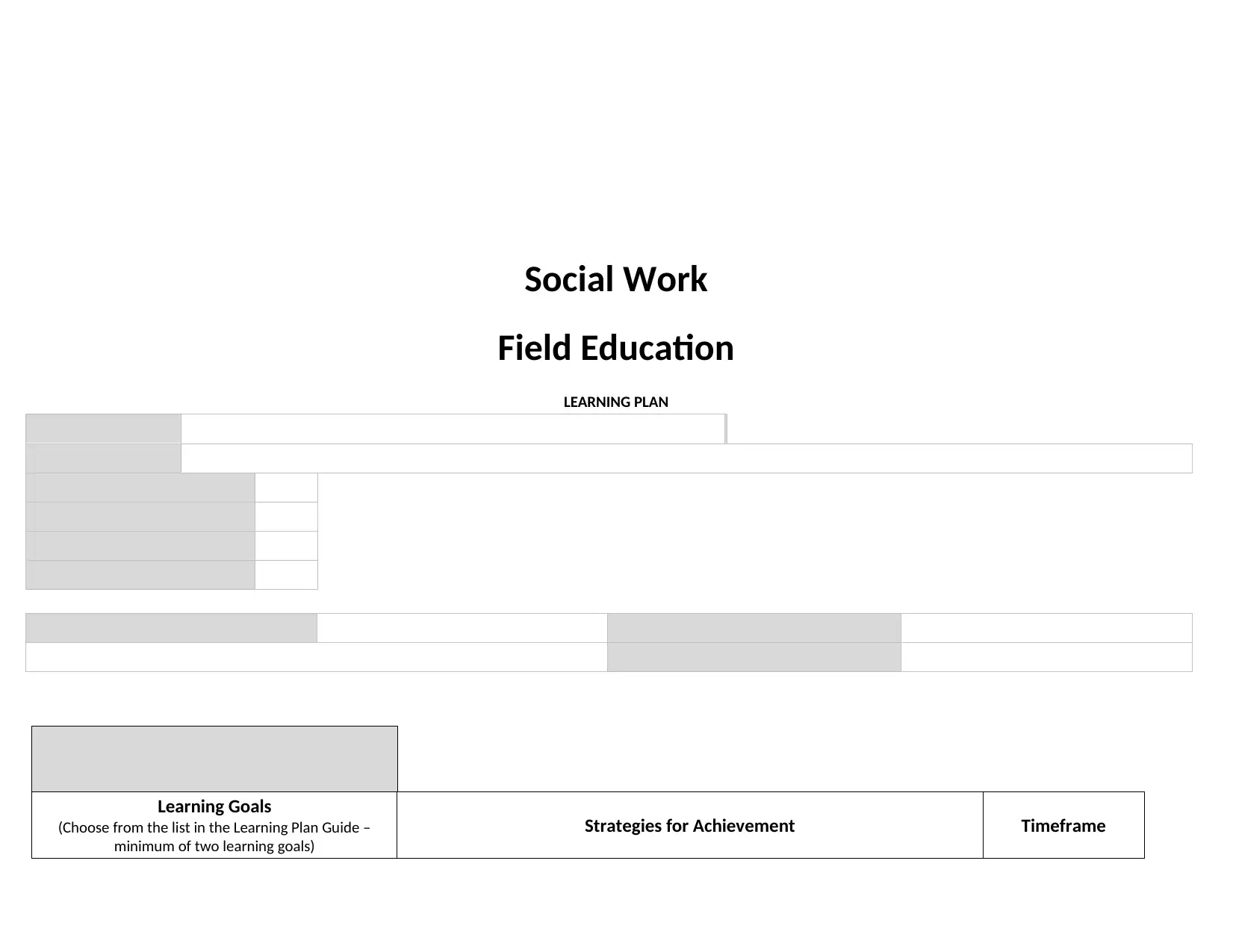
Social Work
Field Education
LEARNING PLAN
Learning Goals
(Choose from the list in the Learning Plan Guide –
minimum of two learning goals)
Strategies for Achievement Timeframe
Field Education
LEARNING PLAN
Learning Goals
(Choose from the list in the Learning Plan Guide –
minimum of two learning goals)
Strategies for Achievement Timeframe
Paraphrase This Document
Need a fresh take? Get an instant paraphrase of this document with our AI Paraphraser
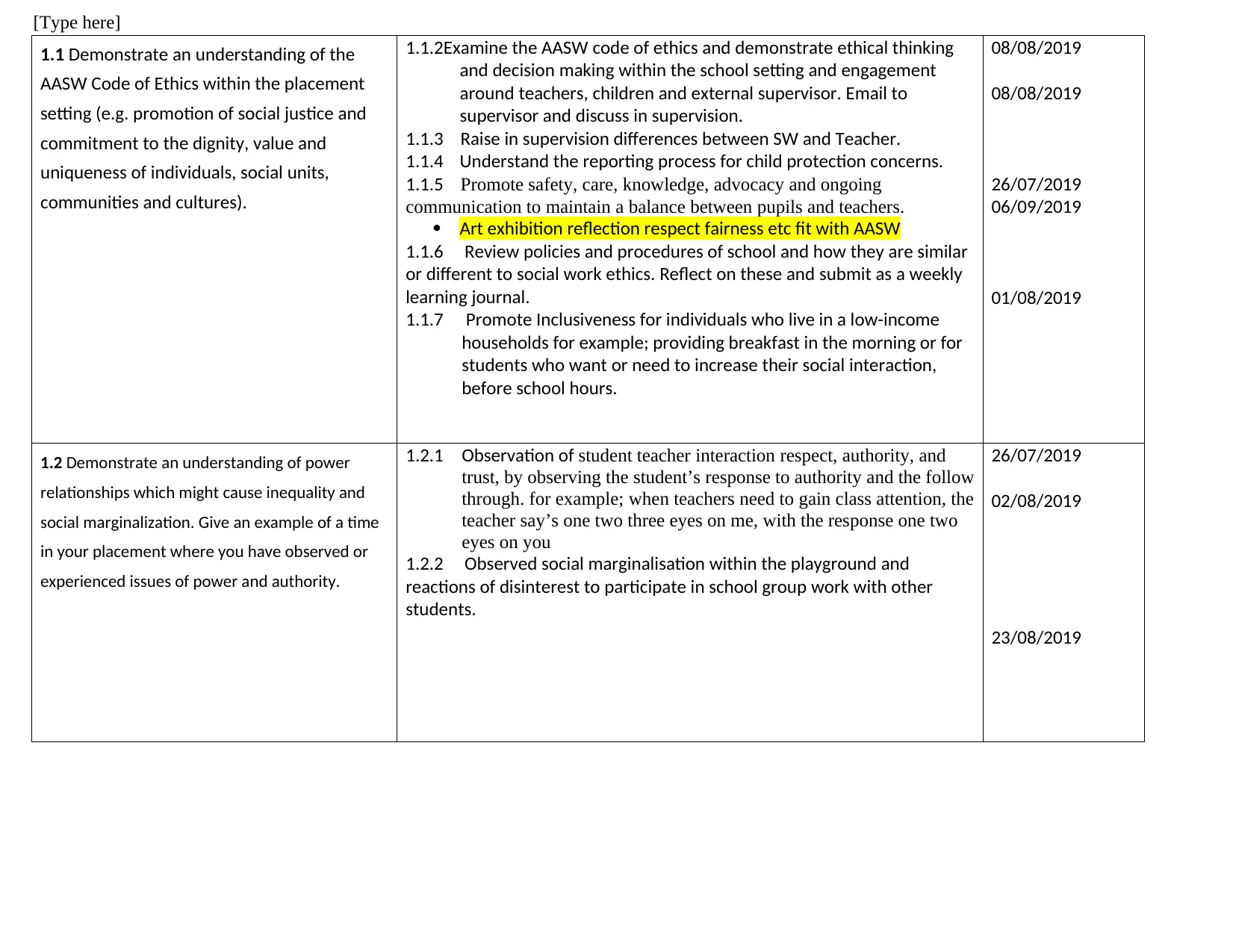
[Type here]
1.1 Demonstrate an understanding of the
AASW Code of Ethics within the placement
setting (e.g. promotion of social justice and
commitment to the dignity, value and
uniqueness of individuals, social units,
communities and cultures).
1.1.2Examine the AASW code of ethics and demonstrate ethical thinking
and decision making within the school setting and engagement
around teachers, children and external supervisor. Email to
supervisor and discuss in supervision.
1.1.3 Raise in supervision differences between SW and Teacher.
1.1.4 Understand the reporting process for child protection concerns.
1.1.5 Promote safety, care, knowledge, advocacy and ongoing
communication to maintain a balance between pupils and teachers.
Art exhibition reflection respect fairness etc fit with AASW
1.1.6 Review policies and procedures of school and how they are similar
or different to social work ethics. Reflect on these and submit as a weekly
learning journal.
1.1.7 Promote Inclusiveness for individuals who live in a low-income
households for example; providing breakfast in the morning or for
students who want or need to increase their social interaction,
before school hours.
08/08/2019
08/08/2019
26/07/2019
06/09/2019
01/08/2019
1.2 Demonstrate an understanding of power
relationships which might cause inequality and
social marginalization. Give an example of a time
in your placement where you have observed or
experienced issues of power and authority.
1.2.1 Observation of student teacher interaction respect, authority, and
trust, by observing the student’s response to authority and the follow
through. for example; when teachers need to gain class attention, the
teacher say’s one two three eyes on me, with the response one two
eyes on you
1.2.2 Observed social marginalisation within the playground and
reactions of disinterest to participate in school group work with other
students.
26/07/2019
02/08/2019
23/08/2019
1.1 Demonstrate an understanding of the
AASW Code of Ethics within the placement
setting (e.g. promotion of social justice and
commitment to the dignity, value and
uniqueness of individuals, social units,
communities and cultures).
1.1.2Examine the AASW code of ethics and demonstrate ethical thinking
and decision making within the school setting and engagement
around teachers, children and external supervisor. Email to
supervisor and discuss in supervision.
1.1.3 Raise in supervision differences between SW and Teacher.
1.1.4 Understand the reporting process for child protection concerns.
1.1.5 Promote safety, care, knowledge, advocacy and ongoing
communication to maintain a balance between pupils and teachers.
Art exhibition reflection respect fairness etc fit with AASW
1.1.6 Review policies and procedures of school and how they are similar
or different to social work ethics. Reflect on these and submit as a weekly
learning journal.
1.1.7 Promote Inclusiveness for individuals who live in a low-income
households for example; providing breakfast in the morning or for
students who want or need to increase their social interaction,
before school hours.
08/08/2019
08/08/2019
26/07/2019
06/09/2019
01/08/2019
1.2 Demonstrate an understanding of power
relationships which might cause inequality and
social marginalization. Give an example of a time
in your placement where you have observed or
experienced issues of power and authority.
1.2.1 Observation of student teacher interaction respect, authority, and
trust, by observing the student’s response to authority and the follow
through. for example; when teachers need to gain class attention, the
teacher say’s one two three eyes on me, with the response one two
eyes on you
1.2.2 Observed social marginalisation within the playground and
reactions of disinterest to participate in school group work with other
students.
26/07/2019
02/08/2019
23/08/2019
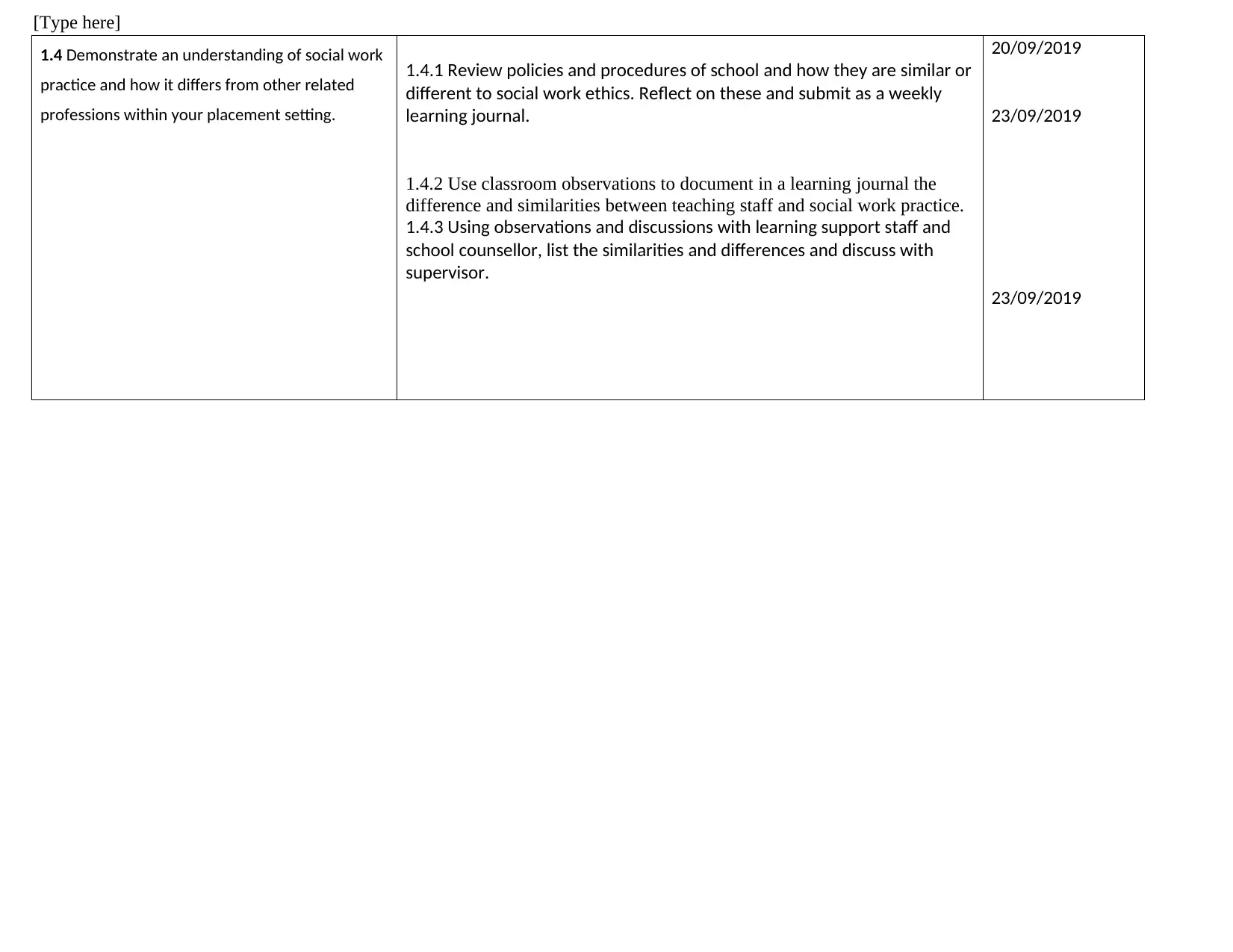
[Type here]
1.4 Demonstrate an understanding of social work
practice and how it differs from other related
professions within your placement setting.
1.4.1 Review policies and procedures of school and how they are similar or
different to social work ethics. Reflect on these and submit as a weekly
learning journal.
1.4.2 Use classroom observations to document in a learning journal the
difference and similarities between teaching staff and social work practice.
1.4.3 Using observations and discussions with learning support staff and
school counsellor, list the similarities and differences and discuss with
supervisor.
20/09/2019
23/09/2019
23/09/2019
1.4 Demonstrate an understanding of social work
practice and how it differs from other related
professions within your placement setting.
1.4.1 Review policies and procedures of school and how they are similar or
different to social work ethics. Reflect on these and submit as a weekly
learning journal.
1.4.2 Use classroom observations to document in a learning journal the
difference and similarities between teaching staff and social work practice.
1.4.3 Using observations and discussions with learning support staff and
school counsellor, list the similarities and differences and discuss with
supervisor.
20/09/2019
23/09/2019
23/09/2019
⊘ This is a preview!⊘
Do you want full access?
Subscribe today to unlock all pages.

Trusted by 1+ million students worldwide
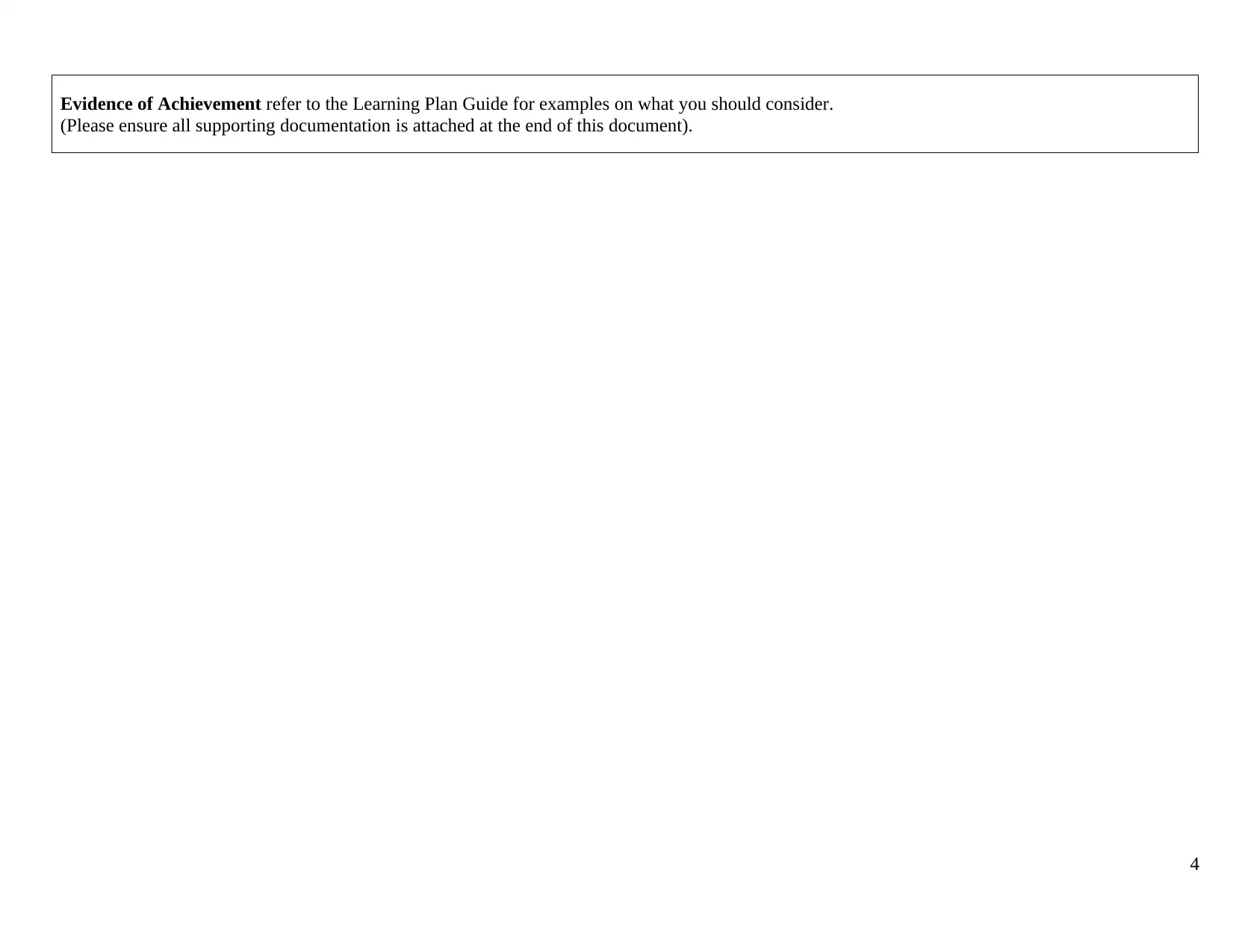
Evidence of Achievement refer to the Learning Plan Guide for examples on what you should consider.
(Please ensure all supporting documentation is attached at the end of this document).
4
(Please ensure all supporting documentation is attached at the end of this document).
4
Paraphrase This Document
Need a fresh take? Get an instant paraphrase of this document with our AI Paraphraser
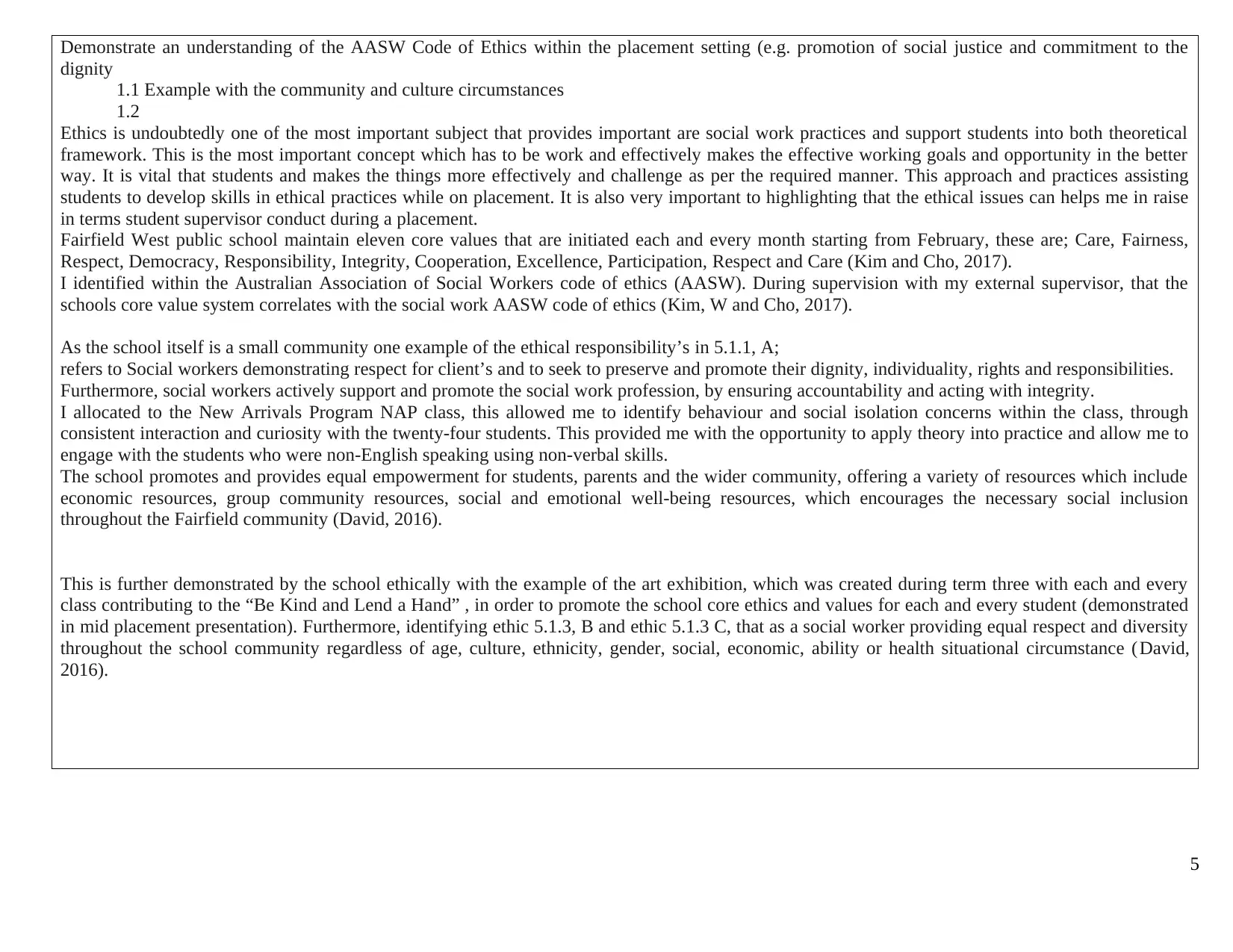
Demonstrate an understanding of the AASW Code of Ethics within the placement setting (e.g. promotion of social justice and commitment to the
dignity
1.1 Example with the community and culture circumstances
1.2
Ethics is undoubtedly one of the most important subject that provides important are social work practices and support students into both theoretical
framework. This is the most important concept which has to be work and effectively makes the effective working goals and opportunity in the better
way. It is vital that students and makes the things more effectively and challenge as per the required manner. This approach and practices assisting
students to develop skills in ethical practices while on placement. It is also very important to highlighting that the ethical issues can helps me in raise
in terms student supervisor conduct during a placement.
Fairfield West public school maintain eleven core values that are initiated each and every month starting from February, these are; Care, Fairness,
Respect, Democracy, Responsibility, Integrity, Cooperation, Excellence, Participation, Respect and Care (Kim and Cho, 2017).
I identified within the Australian Association of Social Workers code of ethics (AASW). During supervision with my external supervisor, that the
schools core value system correlates with the social work AASW code of ethics (Kim, W and Cho, 2017).
As the school itself is a small community one example of the ethical responsibility’s in 5.1.1, A;
refers to Social workers demonstrating respect for client’s and to seek to preserve and promote their dignity, individuality, rights and responsibilities.
Furthermore, social workers actively support and promote the social work profession, by ensuring accountability and acting with integrity.
I allocated to the New Arrivals Program NAP class, this allowed me to identify behaviour and social isolation concerns within the class, through
consistent interaction and curiosity with the twenty-four students. This provided me with the opportunity to apply theory into practice and allow me to
engage with the students who were non-English speaking using non-verbal skills.
The school promotes and provides equal empowerment for students, parents and the wider community, offering a variety of resources which include
economic resources, group community resources, social and emotional well-being resources, which encourages the necessary social inclusion
throughout the Fairfield community (David, 2016).
This is further demonstrated by the school ethically with the example of the art exhibition, which was created during term three with each and every
class contributing to the “Be Kind and Lend a Hand” , in order to promote the school core ethics and values for each and every student (demonstrated
in mid placement presentation). Furthermore, identifying ethic 5.1.3, B and ethic 5.1.3 C, that as a social worker providing equal respect and diversity
throughout the school community regardless of age, culture, ethnicity, gender, social, economic, ability or health situational circumstance (David,
2016).
5
dignity
1.1 Example with the community and culture circumstances
1.2
Ethics is undoubtedly one of the most important subject that provides important are social work practices and support students into both theoretical
framework. This is the most important concept which has to be work and effectively makes the effective working goals and opportunity in the better
way. It is vital that students and makes the things more effectively and challenge as per the required manner. This approach and practices assisting
students to develop skills in ethical practices while on placement. It is also very important to highlighting that the ethical issues can helps me in raise
in terms student supervisor conduct during a placement.
Fairfield West public school maintain eleven core values that are initiated each and every month starting from February, these are; Care, Fairness,
Respect, Democracy, Responsibility, Integrity, Cooperation, Excellence, Participation, Respect and Care (Kim and Cho, 2017).
I identified within the Australian Association of Social Workers code of ethics (AASW). During supervision with my external supervisor, that the
schools core value system correlates with the social work AASW code of ethics (Kim, W and Cho, 2017).
As the school itself is a small community one example of the ethical responsibility’s in 5.1.1, A;
refers to Social workers demonstrating respect for client’s and to seek to preserve and promote their dignity, individuality, rights and responsibilities.
Furthermore, social workers actively support and promote the social work profession, by ensuring accountability and acting with integrity.
I allocated to the New Arrivals Program NAP class, this allowed me to identify behaviour and social isolation concerns within the class, through
consistent interaction and curiosity with the twenty-four students. This provided me with the opportunity to apply theory into practice and allow me to
engage with the students who were non-English speaking using non-verbal skills.
The school promotes and provides equal empowerment for students, parents and the wider community, offering a variety of resources which include
economic resources, group community resources, social and emotional well-being resources, which encourages the necessary social inclusion
throughout the Fairfield community (David, 2016).
This is further demonstrated by the school ethically with the example of the art exhibition, which was created during term three with each and every
class contributing to the “Be Kind and Lend a Hand” , in order to promote the school core ethics and values for each and every student (demonstrated
in mid placement presentation). Furthermore, identifying ethic 5.1.3, B and ethic 5.1.3 C, that as a social worker providing equal respect and diversity
throughout the school community regardless of age, culture, ethnicity, gender, social, economic, ability or health situational circumstance (David,
2016).
5
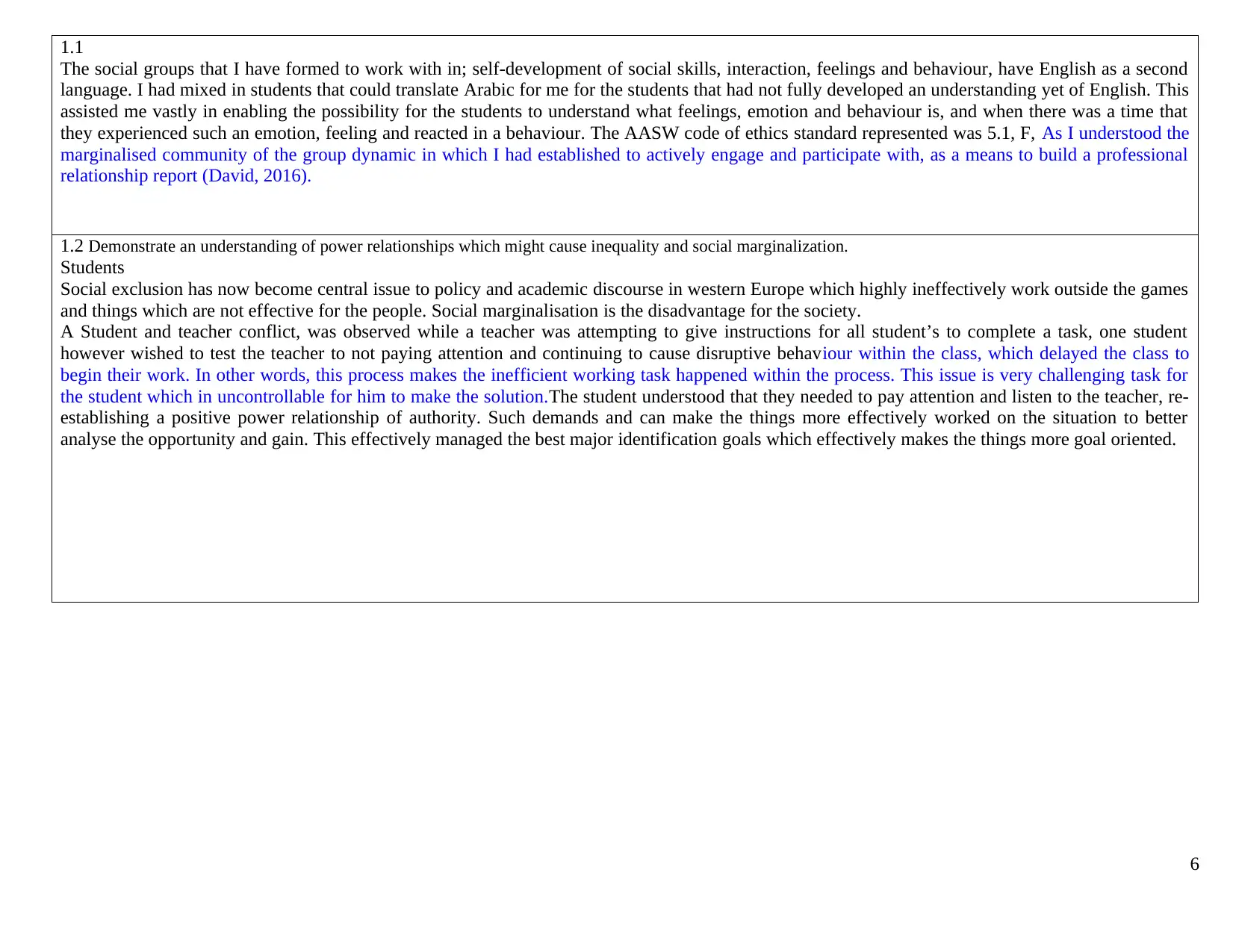
1.1
The social groups that I have formed to work with in; self-development of social skills, interaction, feelings and behaviour, have English as a second
language. I had mixed in students that could translate Arabic for me for the students that had not fully developed an understanding yet of English. This
assisted me vastly in enabling the possibility for the students to understand what feelings, emotion and behaviour is, and when there was a time that
they experienced such an emotion, feeling and reacted in a behaviour. The AASW code of ethics standard represented was 5.1, F, As I understood the
marginalised community of the group dynamic in which I had established to actively engage and participate with, as a means to build a professional
relationship report (David, 2016).
1.2 Demonstrate an understanding of power relationships which might cause inequality and social marginalization.
Students
Social exclusion has now become central issue to policy and academic discourse in western Europe which highly ineffectively work outside the games
and things which are not effective for the people. Social marginalisation is the disadvantage for the society.
A Student and teacher conflict, was observed while a teacher was attempting to give instructions for all student’s to complete a task, one student
however wished to test the teacher to not paying attention and continuing to cause disruptive behaviour within the class, which delayed the class to
begin their work. In other words, this process makes the inefficient working task happened within the process. This issue is very challenging task for
the student which in uncontrollable for him to make the solution.The student understood that they needed to pay attention and listen to the teacher, re-
establishing a positive power relationship of authority. Such demands and can make the things more effectively worked on the situation to better
analyse the opportunity and gain. This effectively managed the best major identification goals which effectively makes the things more goal oriented.
6
The social groups that I have formed to work with in; self-development of social skills, interaction, feelings and behaviour, have English as a second
language. I had mixed in students that could translate Arabic for me for the students that had not fully developed an understanding yet of English. This
assisted me vastly in enabling the possibility for the students to understand what feelings, emotion and behaviour is, and when there was a time that
they experienced such an emotion, feeling and reacted in a behaviour. The AASW code of ethics standard represented was 5.1, F, As I understood the
marginalised community of the group dynamic in which I had established to actively engage and participate with, as a means to build a professional
relationship report (David, 2016).
1.2 Demonstrate an understanding of power relationships which might cause inequality and social marginalization.
Students
Social exclusion has now become central issue to policy and academic discourse in western Europe which highly ineffectively work outside the games
and things which are not effective for the people. Social marginalisation is the disadvantage for the society.
A Student and teacher conflict, was observed while a teacher was attempting to give instructions for all student’s to complete a task, one student
however wished to test the teacher to not paying attention and continuing to cause disruptive behaviour within the class, which delayed the class to
begin their work. In other words, this process makes the inefficient working task happened within the process. This issue is very challenging task for
the student which in uncontrollable for him to make the solution.The student understood that they needed to pay attention and listen to the teacher, re-
establishing a positive power relationship of authority. Such demands and can make the things more effectively worked on the situation to better
analyse the opportunity and gain. This effectively managed the best major identification goals which effectively makes the things more goal oriented.
6
⊘ This is a preview!⊘
Do you want full access?
Subscribe today to unlock all pages.

Trusted by 1+ million students worldwide
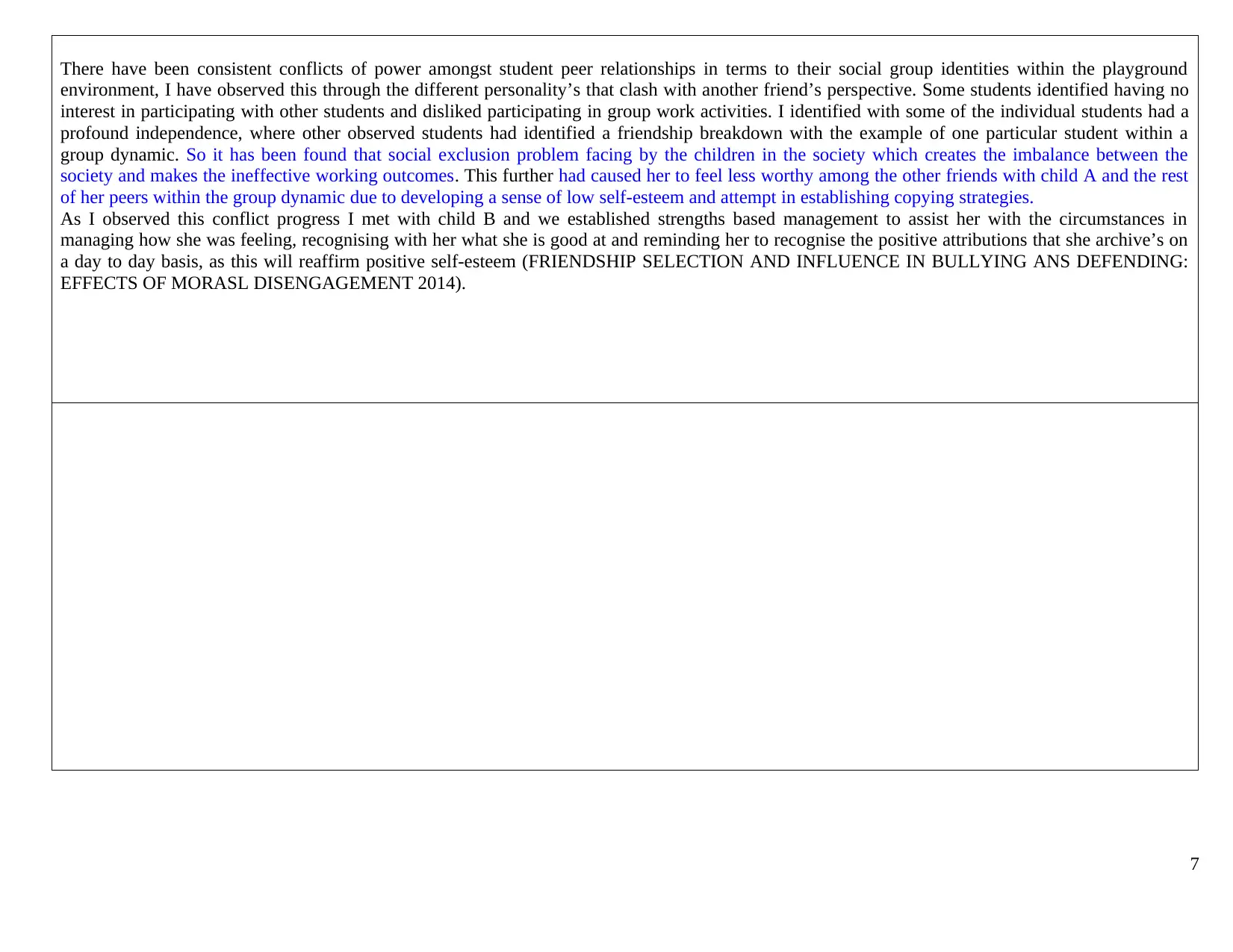
There have been consistent conflicts of power amongst student peer relationships in terms to their social group identities within the playground
environment, I have observed this through the different personality’s that clash with another friend’s perspective. Some students identified having no
interest in participating with other students and disliked participating in group work activities. I identified with some of the individual students had a
profound independence, where other observed students had identified a friendship breakdown with the example of one particular student within a
group dynamic. So it has been found that social exclusion problem facing by the children in the society which creates the imbalance between the
society and makes the ineffective working outcomes. This further had caused her to feel less worthy among the other friends with child A and the rest
of her peers within the group dynamic due to developing a sense of low self-esteem and attempt in establishing copying strategies.
As I observed this conflict progress I met with child B and we established strengths based management to assist her with the circumstances in
managing how she was feeling, recognising with her what she is good at and reminding her to recognise the positive attributions that she archive’s on
a day to day basis, as this will reaffirm positive self-esteem (FRIENDSHIP SELECTION AND INFLUENCE IN BULLYING ANS DEFENDING:
EFFECTS OF MORASL DISENGAGEMENT 2014).
7
environment, I have observed this through the different personality’s that clash with another friend’s perspective. Some students identified having no
interest in participating with other students and disliked participating in group work activities. I identified with some of the individual students had a
profound independence, where other observed students had identified a friendship breakdown with the example of one particular student within a
group dynamic. So it has been found that social exclusion problem facing by the children in the society which creates the imbalance between the
society and makes the ineffective working outcomes. This further had caused her to feel less worthy among the other friends with child A and the rest
of her peers within the group dynamic due to developing a sense of low self-esteem and attempt in establishing copying strategies.
As I observed this conflict progress I met with child B and we established strengths based management to assist her with the circumstances in
managing how she was feeling, recognising with her what she is good at and reminding her to recognise the positive attributions that she archive’s on
a day to day basis, as this will reaffirm positive self-esteem (FRIENDSHIP SELECTION AND INFLUENCE IN BULLYING ANS DEFENDING:
EFFECTS OF MORASL DISENGAGEMENT 2014).
7
Paraphrase This Document
Need a fresh take? Get an instant paraphrase of this document with our AI Paraphraser
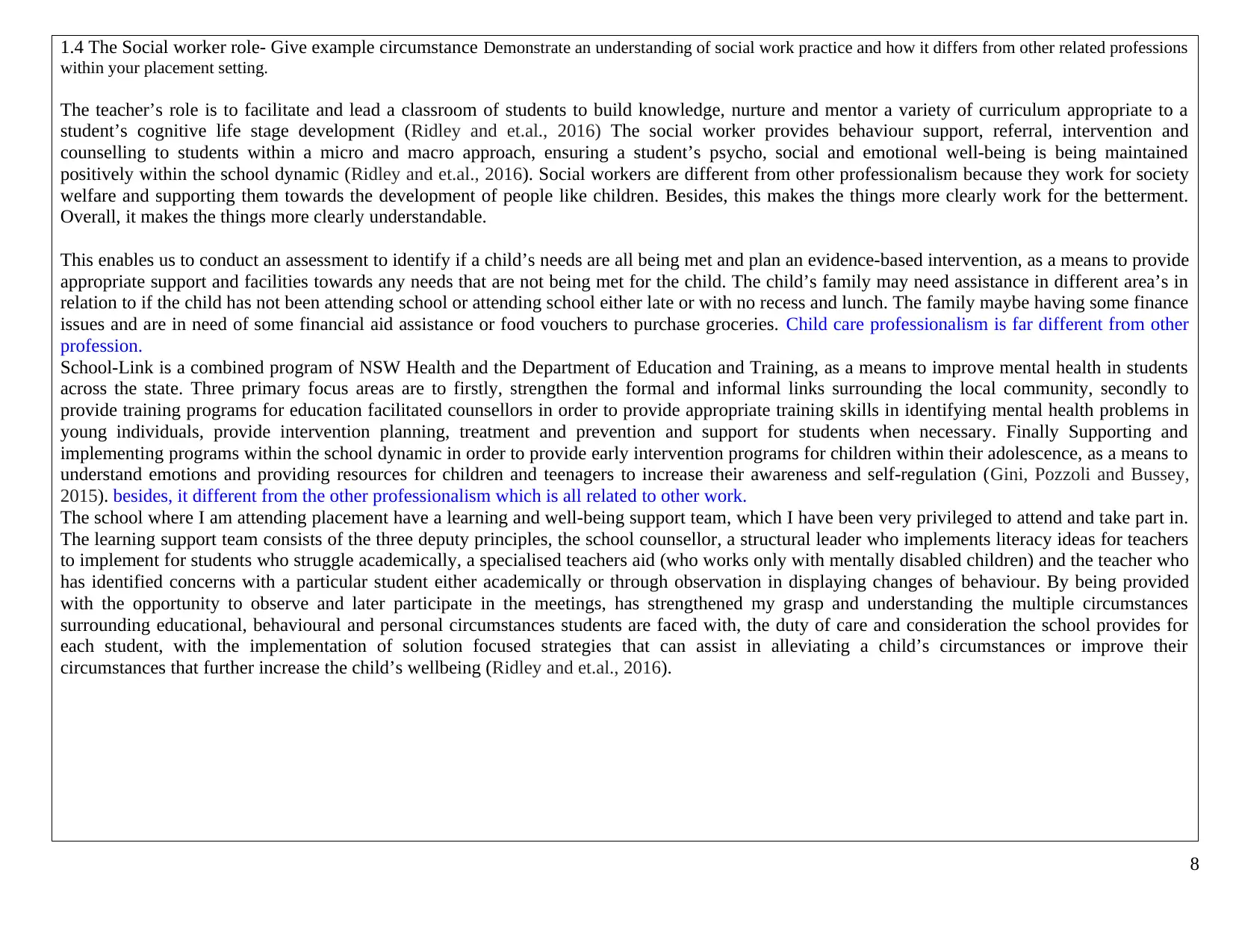
1.4 The Social worker role- Give example circumstance Demonstrate an understanding of social work practice and how it differs from other related professions
within your placement setting.
The teacher’s role is to facilitate and lead a classroom of students to build knowledge, nurture and mentor a variety of curriculum appropriate to a
student’s cognitive life stage development (Ridley and et.al., 2016) The social worker provides behaviour support, referral, intervention and
counselling to students within a micro and macro approach, ensuring a student’s psycho, social and emotional well-being is being maintained
positively within the school dynamic (Ridley and et.al., 2016). Social workers are different from other professionalism because they work for society
welfare and supporting them towards the development of people like children. Besides, this makes the things more clearly work for the betterment.
Overall, it makes the things more clearly understandable.
This enables us to conduct an assessment to identify if a child’s needs are all being met and plan an evidence-based intervention, as a means to provide
appropriate support and facilities towards any needs that are not being met for the child. The child’s family may need assistance in different area’s in
relation to if the child has not been attending school or attending school either late or with no recess and lunch. The family maybe having some finance
issues and are in need of some financial aid assistance or food vouchers to purchase groceries. Child care professionalism is far different from other
profession.
School-Link is a combined program of NSW Health and the Department of Education and Training, as a means to improve mental health in students
across the state. Three primary focus areas are to firstly, strengthen the formal and informal links surrounding the local community, secondly to
provide training programs for education facilitated counsellors in order to provide appropriate training skills in identifying mental health problems in
young individuals, provide intervention planning, treatment and prevention and support for students when necessary. Finally Supporting and
implementing programs within the school dynamic in order to provide early intervention programs for children within their adolescence, as a means to
understand emotions and providing resources for children and teenagers to increase their awareness and self-regulation (Gini, Pozzoli and Bussey,
2015). besides, it different from the other professionalism which is all related to other work.
The school where I am attending placement have a learning and well-being support team, which I have been very privileged to attend and take part in.
The learning support team consists of the three deputy principles, the school counsellor, a structural leader who implements literacy ideas for teachers
to implement for students who struggle academically, a specialised teachers aid (who works only with mentally disabled children) and the teacher who
has identified concerns with a particular student either academically or through observation in displaying changes of behaviour. By being provided
with the opportunity to observe and later participate in the meetings, has strengthened my grasp and understanding the multiple circumstances
surrounding educational, behavioural and personal circumstances students are faced with, the duty of care and consideration the school provides for
each student, with the implementation of solution focused strategies that can assist in alleviating a child’s circumstances or improve their
circumstances that further increase the child’s wellbeing (Ridley and et.al., 2016).
8
within your placement setting.
The teacher’s role is to facilitate and lead a classroom of students to build knowledge, nurture and mentor a variety of curriculum appropriate to a
student’s cognitive life stage development (Ridley and et.al., 2016) The social worker provides behaviour support, referral, intervention and
counselling to students within a micro and macro approach, ensuring a student’s psycho, social and emotional well-being is being maintained
positively within the school dynamic (Ridley and et.al., 2016). Social workers are different from other professionalism because they work for society
welfare and supporting them towards the development of people like children. Besides, this makes the things more clearly work for the betterment.
Overall, it makes the things more clearly understandable.
This enables us to conduct an assessment to identify if a child’s needs are all being met and plan an evidence-based intervention, as a means to provide
appropriate support and facilities towards any needs that are not being met for the child. The child’s family may need assistance in different area’s in
relation to if the child has not been attending school or attending school either late or with no recess and lunch. The family maybe having some finance
issues and are in need of some financial aid assistance or food vouchers to purchase groceries. Child care professionalism is far different from other
profession.
School-Link is a combined program of NSW Health and the Department of Education and Training, as a means to improve mental health in students
across the state. Three primary focus areas are to firstly, strengthen the formal and informal links surrounding the local community, secondly to
provide training programs for education facilitated counsellors in order to provide appropriate training skills in identifying mental health problems in
young individuals, provide intervention planning, treatment and prevention and support for students when necessary. Finally Supporting and
implementing programs within the school dynamic in order to provide early intervention programs for children within their adolescence, as a means to
understand emotions and providing resources for children and teenagers to increase their awareness and self-regulation (Gini, Pozzoli and Bussey,
2015). besides, it different from the other professionalism which is all related to other work.
The school where I am attending placement have a learning and well-being support team, which I have been very privileged to attend and take part in.
The learning support team consists of the three deputy principles, the school counsellor, a structural leader who implements literacy ideas for teachers
to implement for students who struggle academically, a specialised teachers aid (who works only with mentally disabled children) and the teacher who
has identified concerns with a particular student either academically or through observation in displaying changes of behaviour. By being provided
with the opportunity to observe and later participate in the meetings, has strengthened my grasp and understanding the multiple circumstances
surrounding educational, behavioural and personal circumstances students are faced with, the duty of care and consideration the school provides for
each student, with the implementation of solution focused strategies that can assist in alleviating a child’s circumstances or improve their
circumstances that further increase the child’s wellbeing (Ridley and et.al., 2016).
8
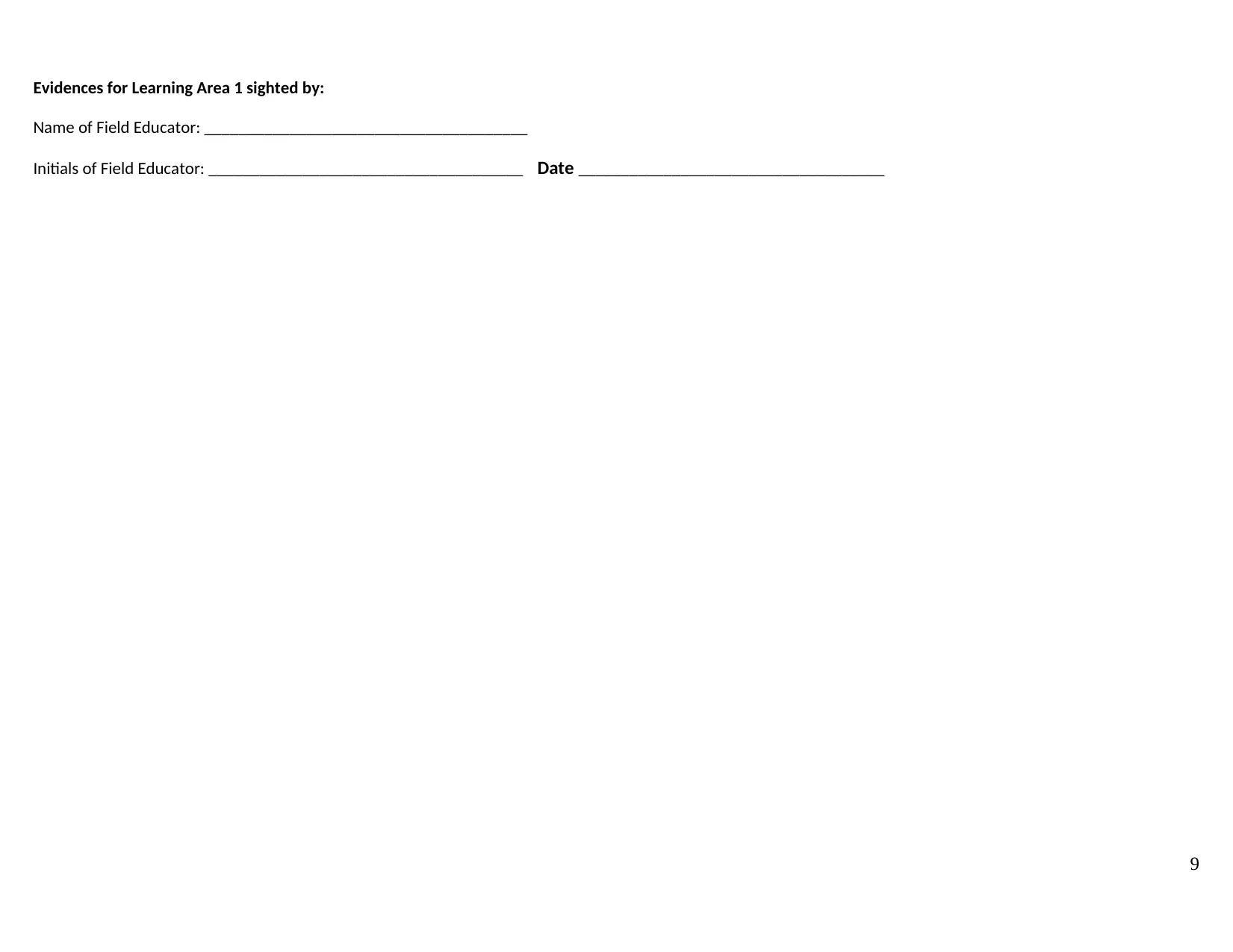
Evidences for Learning Area 1 sighted by:
Name of Field Educator: ______________________________________
Initials of Field Educator: _____________________________________ Date ____________________________________
9
Name of Field Educator: ______________________________________
Initials of Field Educator: _____________________________________ Date ____________________________________
9
⊘ This is a preview!⊘
Do you want full access?
Subscribe today to unlock all pages.

Trusted by 1+ million students worldwide
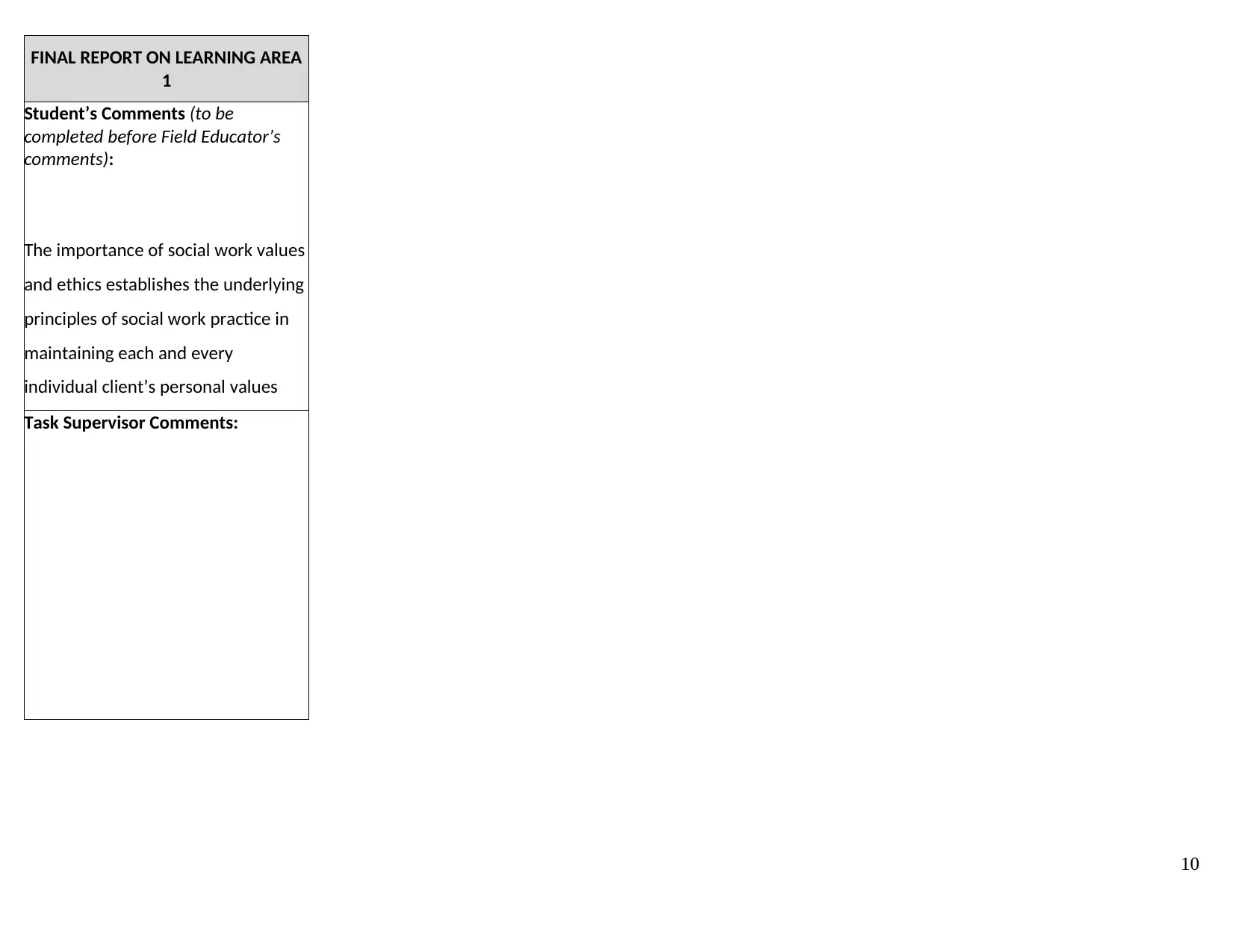
FINAL REPORT ON LEARNING AREA
1
Student’s Comments (to be
completed before Field Educator’s
comments):
The importance of social work values
and ethics establishes the underlying
principles of social work practice in
maintaining each and every
individual client’s personal values
and beliefs without the creation ofTask Supervisor Comments:
10
1
Student’s Comments (to be
completed before Field Educator’s
comments):
The importance of social work values
and ethics establishes the underlying
principles of social work practice in
maintaining each and every
individual client’s personal values
and beliefs without the creation ofTask Supervisor Comments:
10
Paraphrase This Document
Need a fresh take? Get an instant paraphrase of this document with our AI Paraphraser
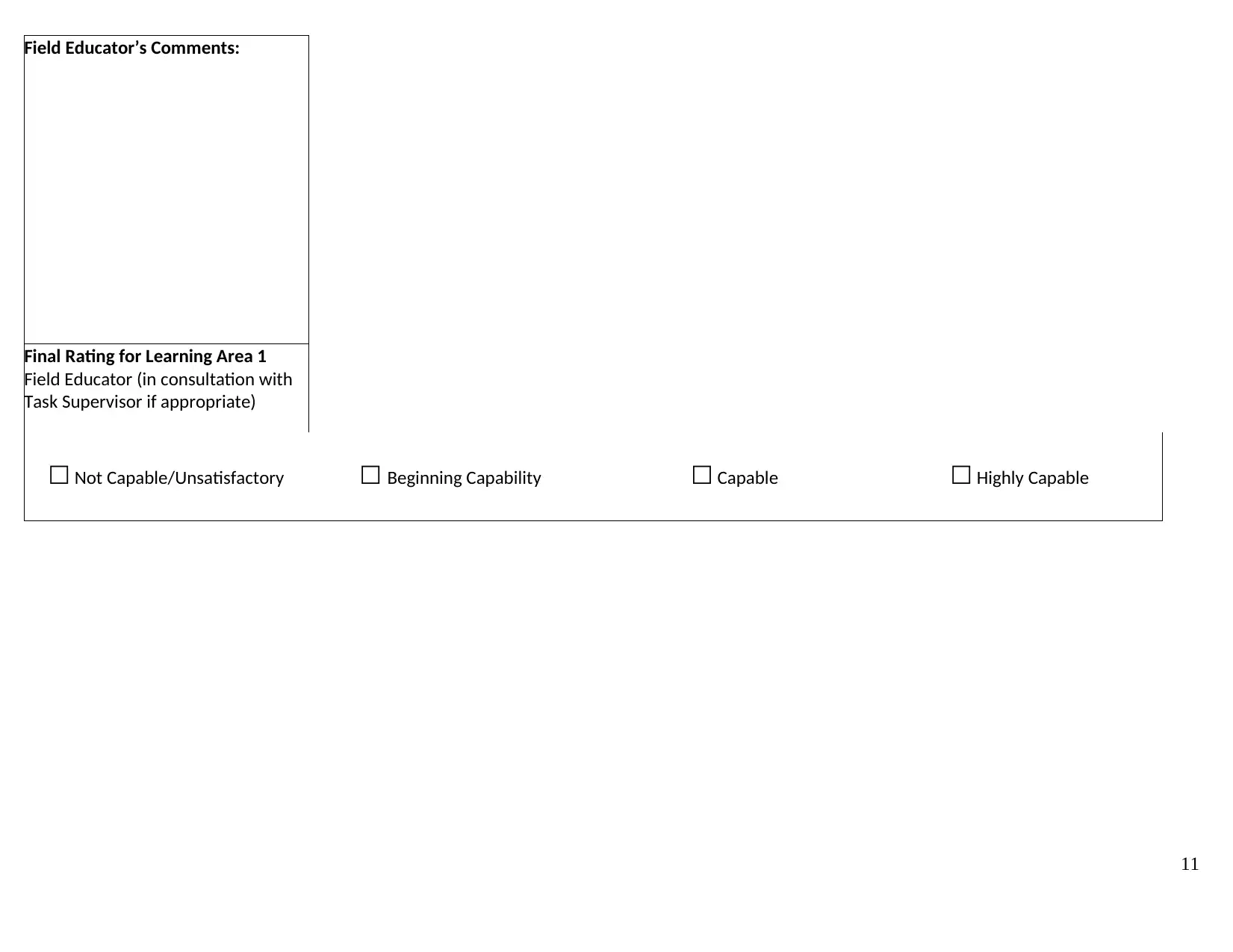
Field Educator’s Comments:
Final Rating for Learning Area 1
Field Educator (in consultation with
Task Supervisor if appropriate)
☐ Not Capable/Unsatisfactory ☐ Beginning Capability ☐ Capable ☐ Highly Capable
11
Final Rating for Learning Area 1
Field Educator (in consultation with
Task Supervisor if appropriate)
☐ Not Capable/Unsatisfactory ☐ Beginning Capability ☐ Capable ☐ Highly Capable
11
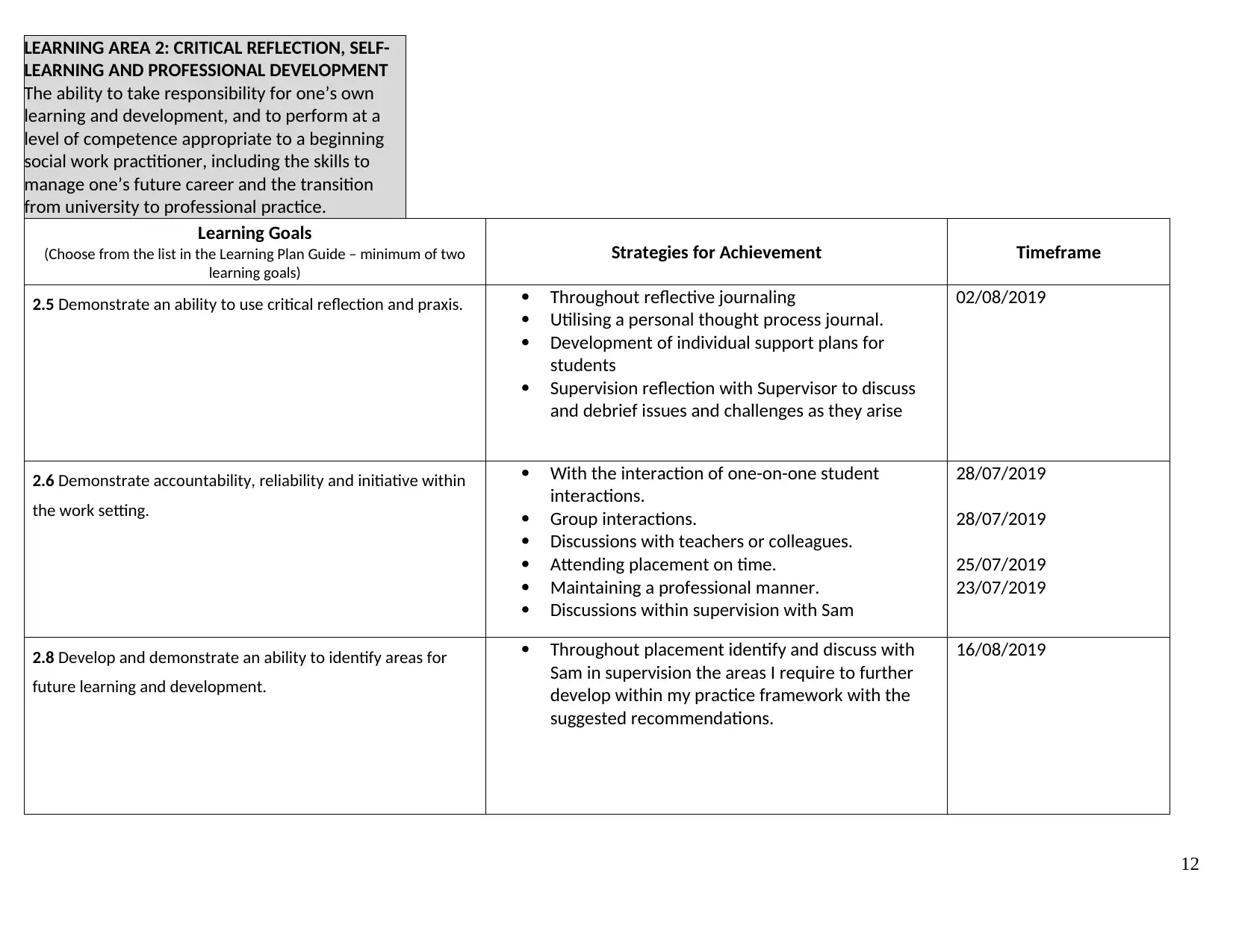
LEARNING AREA 2: CRITICAL REFLECTION, SELF-
LEARNING AND PROFESSIONAL DEVELOPMENT
The ability to take responsibility for one’s own
learning and development, and to perform at a
level of competence appropriate to a beginning
social work practitioner, including the skills to
manage one’s future career and the transition
from university to professional practice.
Learning Goals
(Choose from the list in the Learning Plan Guide – minimum of two
learning goals)
Strategies for Achievement Timeframe
2.5 Demonstrate an ability to use critical reflection and praxis. Throughout reflective journaling
Utilising a personal thought process journal.
Development of individual support plans for
students
Supervision reflection with Supervisor to discuss
and debrief issues and challenges as they arise
02/08/2019
2.6 Demonstrate accountability, reliability and initiative within
the work setting.
With the interaction of one-on-one student
interactions.
Group interactions.
Discussions with teachers or colleagues.
Attending placement on time.
Maintaining a professional manner.
Discussions within supervision with Sam
28/07/2019
28/07/2019
25/07/2019
23/07/2019
2.8 Develop and demonstrate an ability to identify areas for
future learning and development.
Throughout placement identify and discuss with
Sam in supervision the areas I require to further
develop within my practice framework with the
suggested recommendations.
16/08/2019
12
LEARNING AND PROFESSIONAL DEVELOPMENT
The ability to take responsibility for one’s own
learning and development, and to perform at a
level of competence appropriate to a beginning
social work practitioner, including the skills to
manage one’s future career and the transition
from university to professional practice.
Learning Goals
(Choose from the list in the Learning Plan Guide – minimum of two
learning goals)
Strategies for Achievement Timeframe
2.5 Demonstrate an ability to use critical reflection and praxis. Throughout reflective journaling
Utilising a personal thought process journal.
Development of individual support plans for
students
Supervision reflection with Supervisor to discuss
and debrief issues and challenges as they arise
02/08/2019
2.6 Demonstrate accountability, reliability and initiative within
the work setting.
With the interaction of one-on-one student
interactions.
Group interactions.
Discussions with teachers or colleagues.
Attending placement on time.
Maintaining a professional manner.
Discussions within supervision with Sam
28/07/2019
28/07/2019
25/07/2019
23/07/2019
2.8 Develop and demonstrate an ability to identify areas for
future learning and development.
Throughout placement identify and discuss with
Sam in supervision the areas I require to further
develop within my practice framework with the
suggested recommendations.
16/08/2019
12
⊘ This is a preview!⊘
Do you want full access?
Subscribe today to unlock all pages.

Trusted by 1+ million students worldwide
1 out of 72
Your All-in-One AI-Powered Toolkit for Academic Success.
+13062052269
info@desklib.com
Available 24*7 on WhatsApp / Email
![[object Object]](/_next/static/media/star-bottom.7253800d.svg)
Unlock your academic potential
Copyright © 2020–2025 A2Z Services. All Rights Reserved. Developed and managed by ZUCOL.

